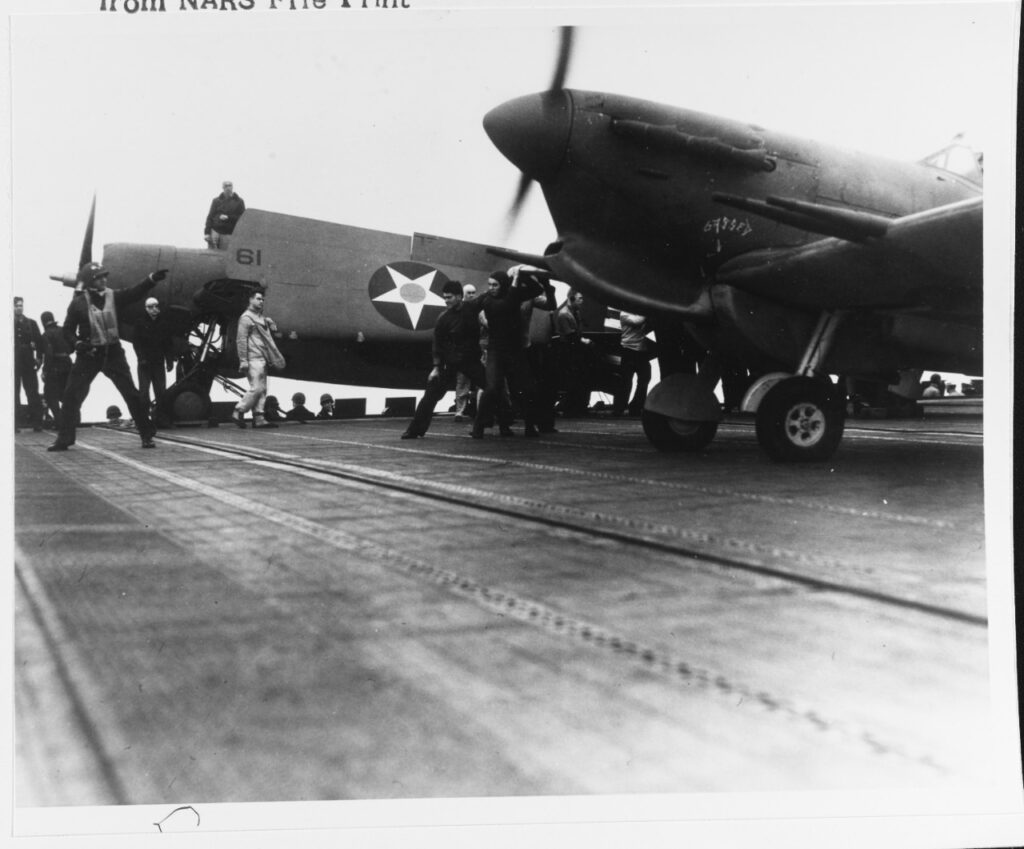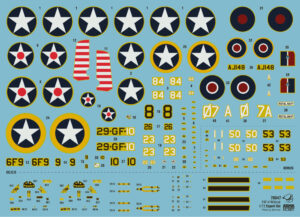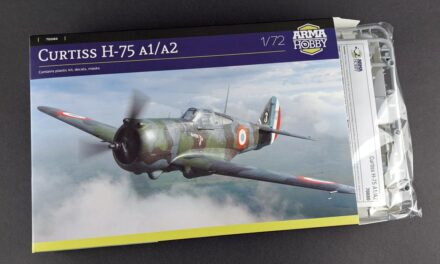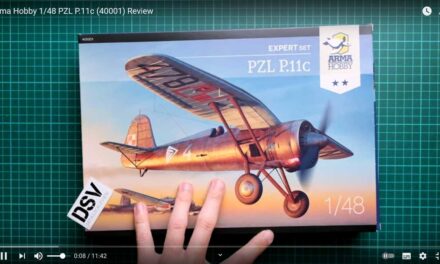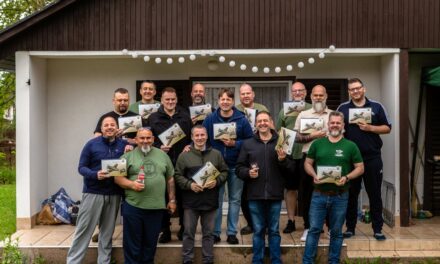Grumman’s new fighter, the F4F-3 Wildcat, which started to enter service with American aircraft carrier-based squadrons towards the end of 1941, was quickly replaced with an upgraded version, the F4F-4. The change aroused controversy, as many pilots were unconvinced by the new aeroplane. Nevertheless, the F4F-4 version with folding wings went on to become the primary US naval fighter of the first half of the war. What were the reasons for its success?
Cover picture: Grumman F4F-4 Wildcat from VF-6, USS Enterprise, April 10, 1942. Artwork by Zbyszek Malicki.
Origins
The Wildcat was essentially a product of the 1930s. Not many know that it was initially envisaged as a biplane (G-16, XF4F-1), the culmination of the development of an entire line of Grumman fighters, among them the FF-1, F2F and F3F. However, the rapid development of technology and the appearance of competing designs resulted in the Wildcat being converted into a monoplane – specifically a mid-wing monoplane. And so the F4F-3 was born. But development brought with it a problem: successive versions of the aeroplane became noticeably larger and heavier. The F3F had a wingspan of 8.7 m, while that of the F4F was expanded to 11.6 m, and its weight increased from 1.8 tons to 3.4 tons. Since overall aircraft dimensions were of critical importance for operation from crowded carrier decks, this led to a plan for equipping the new USN fighter with folding wings.
F4F-4 Wildcat, 41 fighting squadron from USS Ranger, early 1942. Note big fuselage starts with red dots, unit code 41-F-8 and stripes on rudder. Official US Navy photo.
The Prototype
In 1940, Leroy Grumman himself put forward a proposal that would allow the Wildcat to take up less stowage space on ship. This concept came to be known as the Sto-Wing. The wings were to be folded using a hydraulic mechanism, with the axis of rotation arranged such that they were turned to the rear and collapsed along the fuselage, with the edge of attack directed downwards. As a result, the Wildcat’s footprint was reduced from 11.6 m to 4.4 m, which made it possible to increase the numerical strength of carrier-based fighter squadrons from 18 to 27 aircraft.
April 10, 1942, weapon tests on the USS Enterprise deck. Grumman F4F-4 from fighting squadron six with early national insignia. Stripes on rudder are covered with canvas cover. Official US Navy photo.
The US Navy was so taken by the idea that it immediately commissioned the construction of a prototype, and so the last ordered F4F-3 became the first XF4F-4 (build no. 1897). The wing was redesigned, with the axis of rotation being centred on the wing spar and also shifted aft. For this reason, the spar in the section adjoining the fuselage proceeded slantwise to the rear, only running perpendicularly to the aircraft’s axis in the folding wing parts. The incorporation of a wing folding mechanism also impacted the arrangement of the aeroplane’s armament: a third pair of machine guns was added, and all six were moved outward and rearward. This version of the aeroplane was ready by April 1941, and in May it was sent for testing with VF-42 aboard USS Yorktown. But the advantages, obvious as they were, were accompanied by problems. Pilots complained about the aircraft’s weight, which had risen by 310 kg in comparison with the standard F4F-3. This, in turn, impacted rate of climb, speed and manoeuvrability. The US Navy, however, was so impressed with the compactness of the F4F-4 that it immediately placed an order – with the proviso that the aircraft would have to be slimmed down to 3,400 kg. Grumman satisfied this requirement mainly by replacing the hydraulic wing folding mechanism with a manual design. The engine and cowling were standardised and did not undergo further modification throughout the fighter’s entire period of manufacture, while the straight Pitot tube was swapped for a smaller, L-shaped device. Production commenced forthwith, with 5 aircraft leaving the factory by the end of 1941; the rest were completed in 1942.
Grumman F4F-4 Wildcat No F-26 from fighting squadron eight on the USS Hornet deck, April 18, 1942. North American B-25B Mitchell bomber prepared for Doolittle Raid is visible in foreground. Photo: .
The F4F-4 in Front-Line Service
Wildcats with folding wings started arriving at squadrons on the East Coast in the beginning of 1942. The USS Wasp and USS Ranger received their F4F-4s in first order. On the West Coast, VF-6 and VF-8 took delivery of the new fighters towards the end of March 1942, just prior to the Tokyo Raid. At the time of Doolittle’s famous attack, there were already 30 F4F-4s on the USS Hornet, and 22 F4F-4s and 5 F4F-3s on the USS Enterprise. The Wildcats were not used in the raid, however. Following the Battle of the Coral Sea, VF-3 squadron collected its new aeroplanes and embarked on USS Yorktown, soon rejoining the conflict. The new Wildcat had to wait for its début until the Battle of Midway, which involved units from three aircraft carriers – the USS Yorktown, USS Enterprise, and USS Hornet. From this moment on, the aircraft served as the primary fighter of the US Navy/US Marines right until the end of 1943, when it was supplanted by the Corsairs and Hellcats.
Before Doolittle Raid, F4F-4 with folded wings on USS Hornet flightdeck. Photo: US Navy.
Large Red Dots
After the attack on Pearl Harbor drew the United States into the conflict, American aircraft paint schemes and markings were quickly altered, with insignia denoting state affiliation being enlarged and placed at 6 different points. Thus, the majority of US Navy aeroplanes were emblazoned with enormous stars. These can be seen on historical photographs of F4F-3s, SBD-2/3s, PBY-5s, etc., and also featured – albeit briefly – on the F4F-4s. Large stars with red circles were used on the Wildcats from USS Wasp and USS Ranger in the Atlantic, while those from the USS Enterprise and USS Hornet had insignia of standard dimensions.
“Operation Bowery”, delivery of Spitfires to Malta, May 9, 1942. Ltn. Dave Mc Campbell, future US Navy ace, check Spitfire Vc before take off from USS Wasp. Grumman F4F-4 Wildcat with folded. Last days of early “red dot” markings. Official US Navy photo.
It was soon noticed, however, that painting red circles on US aeroplanes was not altogether sensible, as the marking very closely resembled the Hinomaru (the Japanese national flag). For this reason, the red areas within the stars were painted over starting May. The red and white stripes on rudders met with the same fate. The evolution of American aircraft insignia is an interesting topic, but one too vast to be explored in detail in the present article.
Grumman Martlet Mk II, British derivative of F4F-3A with folding wings introduced then in F4F-4. Aeroplane from 888 squadron FAA (HMS Formidable), Oran, Algieria, December 14, 1942. Artwork by: Zbyszek Malicki.
The British Connection
The first Wildcats in British service were known as the Martlet Mk.I, and had initially been intended for France. The Fleet Air Arm (FAA) took a liking to the fighter, and already in mid-1940 it ordered 100 Martlet Mk.IIs, which were practically identical with the F4F-3A (the weaker R-1830-90 engine). The first nine aircraft were delivered in March 1940. When information reached the FAA that work was underway on a version of the Wildcat which would have folding wings, it immediately expressed its interest. The remaining Martlet Mk.IIs were made with wings and armament identical to the F4F-4. Only the engine and engine cowling were different. These aircraft were used by 11 FAA squadrons.
English Translation by Maciek Zakrzewski.
Grumman Martlet Mk II, 888 squadron FAA from HMS Formidable, Oran, Algieria, December 14, 1942. Official US Navy photo.
See also:
- F4F-4 Wildcat Expert Set and other model kits in the Arma Hobby webstore link . Set 70047 includes decals for colour profiles from this article.
Wanted to be Philanthropist, statesman and patron of the arts. Temporarily focused on developing scale model production in Poland. Co-founder of Arma Hobby. Designer of kits: TS-11 Iskra, PZL P.7a, Fokker E.V, PZL P.11c, Hawker Hurricane, Yak-1b, FM-2 Wildcat, P-51B/C Mustang and 1/48 Hurricane.
This post is also available in:
 polski
polski







